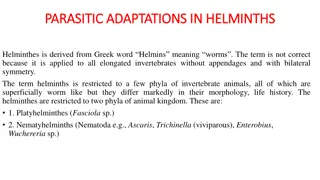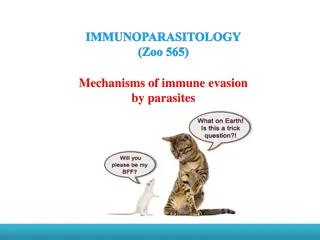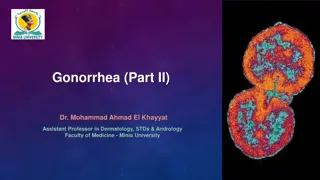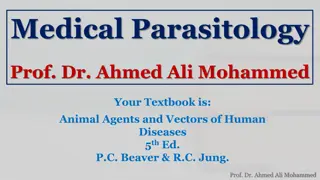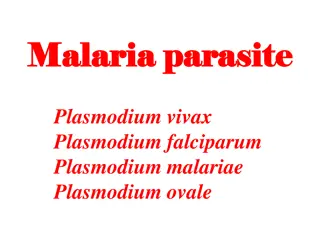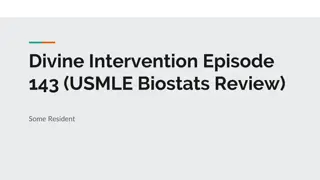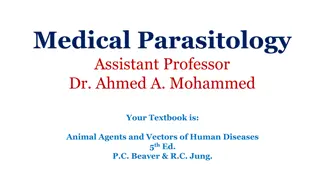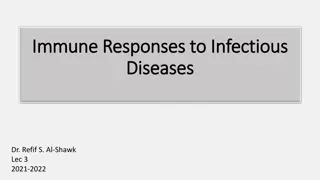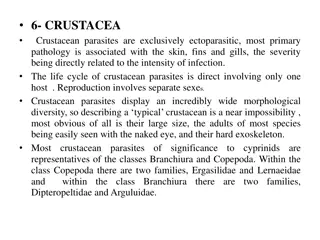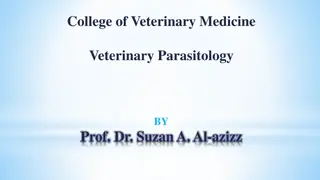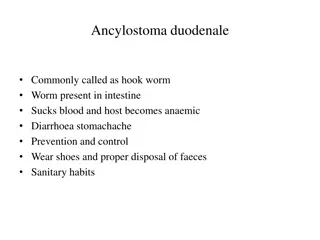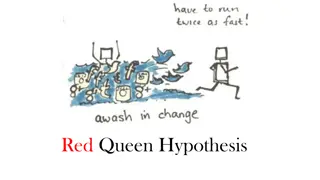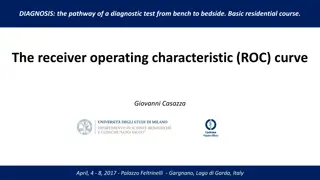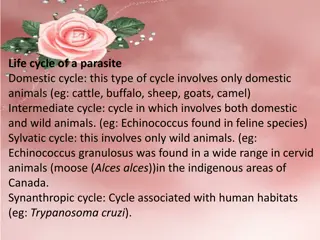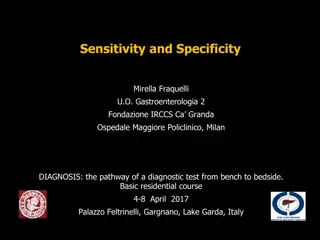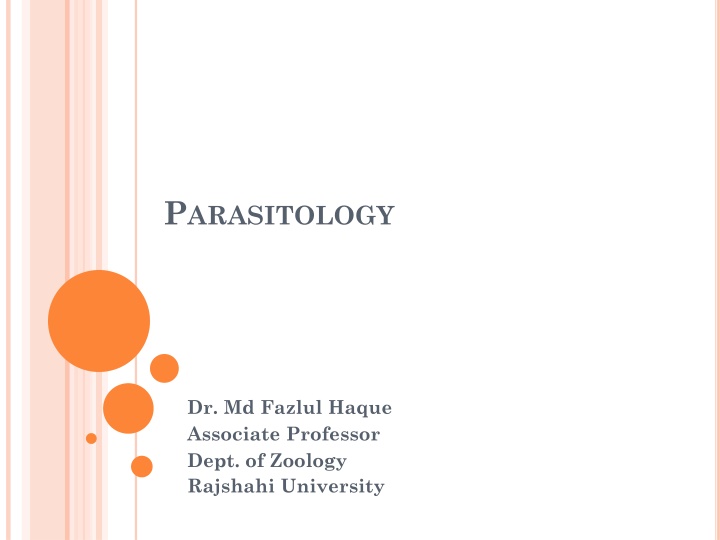
Understanding Host Classification in Parasitology
Learn about the different types of hosts in parasitology, including definitive hosts, intermediate hosts, reservoir hosts, and paratenic hosts. Explore the roles these hosts play in the life cycle of parasites and their significance in the transmission of infections. Gain insights into how hosts interact with parasites and the importance of host classification in understanding parasitic diseases.
Download Presentation

Please find below an Image/Link to download the presentation.
The content on the website is provided AS IS for your information and personal use only. It may not be sold, licensed, or shared on other websites without obtaining consent from the author. If you encounter any issues during the download, it is possible that the publisher has removed the file from their server.
You are allowed to download the files provided on this website for personal or commercial use, subject to the condition that they are used lawfully. All files are the property of their respective owners.
The content on the website is provided AS IS for your information and personal use only. It may not be sold, licensed, or shared on other websites without obtaining consent from the author.
E N D
Presentation Transcript
PARASITOLOGY Dr. Md Fazlul Haque Associate Professor Dept. of Zoology Rajshahi University
HOST What is host? Host is defined as an organism which- harbours the parasite and provides the nourishment and shelter. are relatively larger in size and longer in lifetime in comparison to their parasites. are not directly killed by parasites. What is carrier? Carrier is an individual (not all member of species/group) who harbours - parasite without any clinical symptoms of disease, and can acts as an important source of infection to other individuals in epidemiology
TYPES OF HOST Hosts are classified according to their role in the life cycle of the parasite into following types: Definitive host The host that harbours the adult or sexually mature stages of the parasite is called definitive host or the host in whom sexual reproduction occurs is called definitive host man is definitive haematobium (Blood fluke), e.g. host for Schistosoma e.g. female Anopheles mosquito is definitive host for Plasmodium species (malaria parasites).
TYPES OF HOST Intermediate host The host that harbours larval or sexually immature stages of the parasite is called intermediate host or the host in whom asexual reproduction occurs is called intermediate host e.g. Man is intermediate host of malaria parasites. e.g. Two intermediate hosts termed 1st and 2nd intermediate host may be needed for completion of a parasite's life cycle, e.g. Pirenella conica snail is the 1st intermediate host, while Tilapia fish is the 2nd intermediate host for Heterophyes heterophyes (small parasitic fluke).
TYPES OF HOST Reservoir host The host (species/group) that makes the parasite available for the transmission to another host and is usually not affected by the infection (no clinical symptom). It differs from a carrier which is an individual (not all member of species/group) who harbours parasite without clinical symptoms. e.g. sheep are Reservoir host for Fasciola hepatica.
TYPES OF HOST Paratenic or transport host The host in whom the parasite does not undergo any development but remains another host is called Paratenic or transport host . alive and infective to Paratenic hosts fill the gap between the hosts. For example, dogs and pigs may carry hookworm (Ancylostoma duodenale) eggs from one place to another, but the eggs do not hatch or pass through any development in these animals. It differs from Vector which is an animal (usually arthropods) that transmits parasites from one host to another, e.g. female sand fly transmits Leishmania parasites.
TYPES OF HOST Typical or Natural host A host that is naturally infected with certain species of parasite is called typical or natural host. e.g. Rodents are natural host for Hymenolepis diminuta (rat tapeworm) Accidental host A host that is under normal circumstances not infected with the parasite is called accidental host Human is an accidental diminuta (rat tapeworm) host for Hymenolepis
HOST AS AN ENVIRONMENT OF PARASITE Environment: The environment is the sum total of physical and biotic condition influencing the response of the organisms (S. C. Kendeigh, 1974) The physical and biological conditions of host have both positive (good) impact on life of parasite. negative (bad) impact on life of parasite.
HOST AS AN ENVIRONMENT OF PARASITE Positive impact: Provide ready-made nourishment (degree of impact depend on availability of nutrients) Provide ready-made shelter Help in reproduction Protect from predator and mechanical injuries Protect from adverse effect of physical factors such as temperature, Ph, humidity, water activity, osmotic pressure Negative impact: Elimination or suppression by host immunity (Innate immunity and adaptive immunity) Elimination or suppression because of competition for nutrient and space
HOST PARASITE RELATIONSHIP Once the infecting organism is introduced into the body of the host, it reacts in different ways and this could result in: Carrier state A perfect host parasite relationship where tissue destruction by a parasite is balanced with the host s tissue repair. At this point the parasite and the host live harmoniously, i.e. they are at equilibrium. Disease state This is due to an imperfect host parasite relationship where the parasite dominates over the host . It can result either from lower resistance of the host or a higher pathogenicity of the parasite. Parasite destruction It occurs when the host dominates over the parasites. It can result either from higher resistance of the host or a lower pathogenicity of the parasite.
HOST SPECIFICITY Host specificity can be defined as natural adaptability of a particular parasite to certain species or group of host. Parasites can be very particular about which host species they will use. dengue fever
HOST SPECIFICITY Depending on host specificity parasites can be classified into following types: Oioxenous parasite: A parasite that is specific for a single host species is Example- HIV for human; Eimeria tenella (Intracellular protozoa) which infects only chickens. Stenoxenous parasite: A parasite that parasitizes closely-related hosts is called Stenoxenous parasite. Example- Trichinellosis (trichinosis) nematodes (roundworms) of the genus Trichinella in many carnivorous and omnivorous mammals. Euryxenous parasite: A parasite that parasitizes unrelated hosts is called euryxenous parasite. Example- Toxoplasma gondi for Birds and Mammals. called Oioxenous parasite. is caused by
HOST SPECIFICITY Host-specificity is determined by a complex of factors, some obvious and others still obscure. Depending on requirements, host-specificity can be following types. Ecological specificity: The first requirement is that the prospective host shares its environment with the parasite; e.g. parasites of dolphins might not have much probability to infect humans who do not live near the sea (although modern food transport networks have changed this!). Ethological specificity: Second requirement is that host behavior must expose it to the parasite; e.g. people who eat pork may acquire parasites intended for pig such as pork tape worm Taenia solium. Physiological specificity: The final requirement is that once the parasite comes into contact with the host, it must recognize appropriate cues and feel comfortable within its new surroundings. Obviously, this last determinant of host- specificity is the one we understand least.
PHYSIOLOGICAL SPECIFICITY IS DETERMINED BY SEVERAL STEPS: Parasites interact with host secretions and surfaces and membranes. During this interaction, parasites must recognize and configurations (receptors/ligands) of host. Parasites must need to detect delicate variations in metabolites in host which allows them to follow road- maps for selection of safe and suitable places for them in host Parasites need to make critical changes in behaviour and development according physiology/behaviour. Parasites must be satisfied with their diet available in host (host intestinal contents, blood and/or tissues). Clearly, all these combinations are unique for each host species, and vary even among individuals within a species. respond to molecular to changes in host


